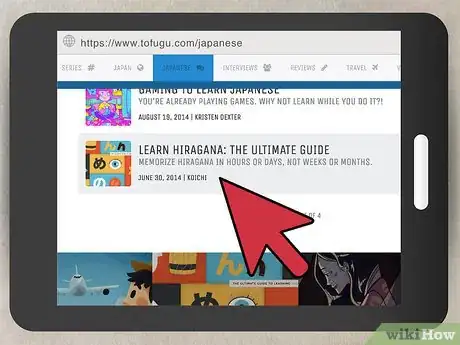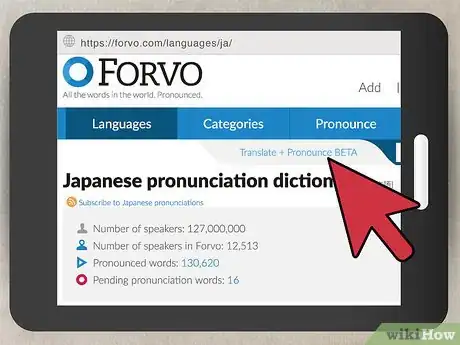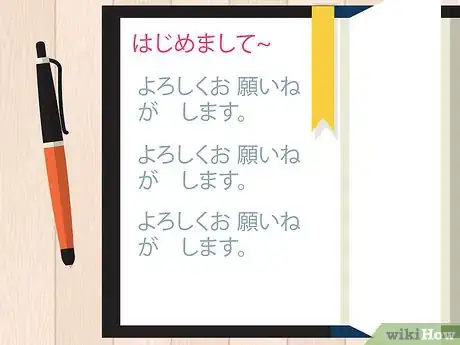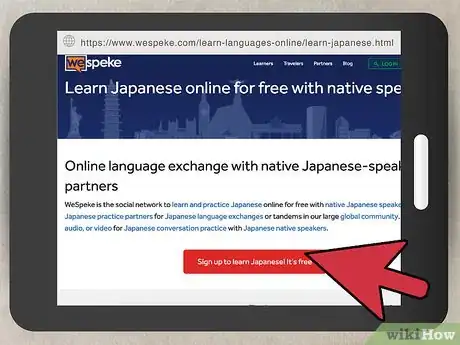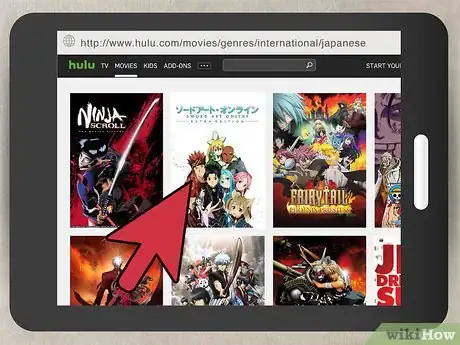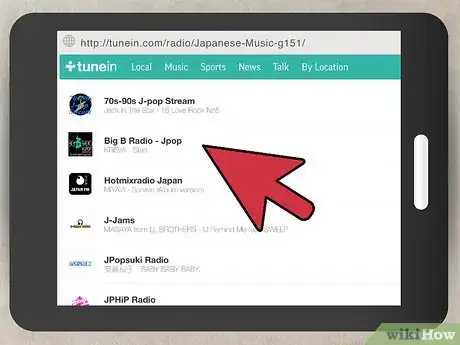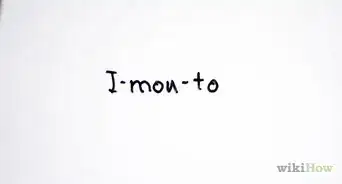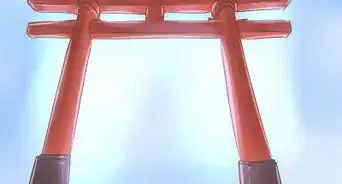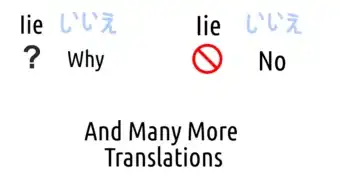This article was co-authored by wikiHow Staff. Our trained team of editors and researchers validate articles for accuracy and comprehensiveness. wikiHow's Content Management Team carefully monitors the work from our editorial staff to ensure that each article is backed by trusted research and meets our high quality standards.
There are 13 references cited in this article, which can be found at the bottom of the page.
wikiHow marks an article as reader-approved once it receives enough positive feedback. In this case, 84% of readers who voted found the article helpful, earning it our reader-approved status.
This article has been viewed 171,127 times.
Learn more...
Do you have an interest in Japan and its language? Do you want to broaden your horizon and learn another language without having to immediately commit to a strict regime? Learning a language can be fun and challenging at the same time, but many people can't or don't want to invest in courses or lessons inside a classroom. By studying the basics, practicing the language, and exploring Japanese in new ways, you can experience the joy of learning a new language.
Steps
Learning the Basics
-
1Study Japanese writing systems. The Japanese language uses four writing systems. In order to learn Japanese, you will need to study each of them. You can visit https://www.tofugu.com/japanese to view each writing system and take beginning lessons to learn each one.
- Hiragana is the Japanese alphabet. It consists of 51 phonetic characters. Each character stands for one sound. Begin by studying and memorizing these characters. Once you understand Hiragana, you will know how to pronounce any word in Japanese.[1]
- Katakana is a series of characters used to stand for non-Japanese words (such as fast food or California). It is a good idea to learn the Katakana phrases for words you commonly use.[2]
- Kanji are actually Chinese symbols that are used to stand for words and phrases in Japanese. Whereas Hiragana symbols are more like “letters” (depicting simple sounds), Kanji symbols depict complete words.[3]
- Romaji is a system of using English letters to spell Japanese words. A little Romaji will be helpful at first (especially for learning initial key phrases) but if you rely too much on on it, you are unlikely to move on to a real understanding of the language. Instead, focus mostly on Hiragana, Katakana, and Kanji.[4]
-
2Practice Japanese pronunciation. There are 46 sounds in the Japanese language. These sounds are composed of one of five vowel sounds, by a vowel-consonant combination. (There is only one exception, which is a sound composed of only a consonant). You can begin studying pronunciation by learning how to pronounce each character in hiragana and katakana.
- Visit http://www.forvo.com/languages/ja/ to take beginning lessons in Japanese pronunciation.
Advertisement -
3Learn some key phrases. Knowing some key phrases will allow you to begin practicing. Although Romaji should not be heavily relied upon, using Romaji to learn these basic phrases is OK for beginners.[5]
- Hello - Kon'nichiwa
- Nice to meet you - Hajime mash'te
- Goodbye - Sayonara
- I'm fine, thanks - Watashiwa genki desu. Arigato.
- Thank you very much - Domo arigato gozaimasu
- Please (asking for something) - Kudasai
- Please (offering something) - Dozo
- Do you understand? Wakarimasuka
-
4Learn the rules of grammar. Japanese grammar is very different from grammar in English, so try not to apply English rules of grammar to your Japanese study. Learning Japanese grammar will take some time to get used to. Purchase a Japanese grammar workbook and begin following the lessons. Some examples include "Practice Makes Perfect: Basic Japanese" and "A Guide to Japanese Grammar" by Tae Kim. Or locate free online resources (such as Duolingo) to study Japanese grammar.[6] Here are some basic tips:
- Nouns do not have gender. Also, most nouns don't have separate plural forms.
- In Japanese, the subject is optional and may be omitted.
- The predicate is always at the end of the sentence.
- Verbs do not change according to the subject (he/she/it). They also don't change according to number (singular/plural, like I/we or he/they).[7]
- Personal pronouns (such as I or you) differ according to the level of formality of a given situation.
Practicing the Language
-
1Strengthen your grasp on the writing systems. If reading and writing is important to your understanding of Japanese, it is crucial to spend time studying all four of the Japanese written systems. Hiragana and katakana can be learned in as little as a few weeks, and you can use them to write anything you want in Japanese. Kanji will take much longer to learn, but it is also important. Begin practicing Kanji as well.
- A good workbook is a great way to begin practicing your reading and writing.
- You may also want to try online resources, like Duolingo.
-
2Talk to someone online. A fun option for practicing Japanese is to video-chat with a native speaker. Look for online resources that pair language partners together. If you find someone who is a good fit, begin practicing with them 1-2 times per week.[8]
-
3Use flashcards. Purchase Japanese language flashcards, or make them yourself at home. You can purchase (or make) flashcards for each language system, to study specific phrases, and to memorize grammar fundamentals. Flashcards can be a fun way to strengthen your vocabulary in all three language systems (Hiragana, Kanji, or Katakana).[11]
- Try posting the flashcards around your house to label items with their Japanese names.
- Have a friend quiz you with flashcards to practice your memorization.
- Use the flashcards to quiz yourself.
-
4Use online resources. There are numerous online language programs that can help you to learn and practice Japanese, such as Duolingo, Tofugu, and Japanese 101. Seek out these free resources and make practicing Japanese a daily routine.[12]
Experiencing the Language in Fun Ways
-
1Read. Look for Japanese books, comic books, or newspapers. When you try to read in Japanese, you expose yourself to new words while strengthening your skills and encountering Japanese culture.
-
2Watch Japanese movies. Another fun way to expose yourself to Japanese is to watch Japanese movies. Movies can expose you to a wider range of terms (including slang) and provide some entertainment. You can even use English subtitles to help you understand the plot.[13]
-
3Listen to Japanese radio. Just like movies, listening to Japanese radio can be a good way to hear new words and sharpen your listening skills. Look for Japanese music with lyrics, or Japanese talk radio.[14]
-
4Immerse yourself. If you have the opportunity to experience an immersion in the Japanese language, take it! Perhaps you can visit Japan, or even an authentic Japanese restaurant. This will enable you to speak to people in Japanese and watch them speak. There is really no better way to learn a new language.[15]
Community Q&A
-
QuestionI watch anime a lot. I know the basic phrases as well. I also listen to Japanese audio. Is it a good start?
 DoggoTop AnswererThis is a great start, surrounding yourself with the language. However, you must learn the writing systems and correct pronunciation (in most languages, words can end up slurred or dialect).
DoggoTop AnswererThis is a great start, surrounding yourself with the language. However, you must learn the writing systems and correct pronunciation (in most languages, words can end up slurred or dialect). -
QuestionWhich area should I spend most of my time studying?
 Community AnswerThe most difficult part, the kanji system. Practice writing and memorizing the pronunciations (on-readings and kun-readings). The two writing systems (Kana) are very basic; you can learn and master in under 2 months. You can learn Japanese grammar as you go; see examples of the kanji in dictionaries. In my opinion, learning a language using another language is wrong; if you're only beginning, refrain from relying on romaji once you get the idea on how to "pronounce" the character, its definition and the rules of grammar. Children learn through sheer mimicking and repetition, and that's the best way of learning a language.
Community AnswerThe most difficult part, the kanji system. Practice writing and memorizing the pronunciations (on-readings and kun-readings). The two writing systems (Kana) are very basic; you can learn and master in under 2 months. You can learn Japanese grammar as you go; see examples of the kanji in dictionaries. In my opinion, learning a language using another language is wrong; if you're only beginning, refrain from relying on romaji once you get the idea on how to "pronounce" the character, its definition and the rules of grammar. Children learn through sheer mimicking and repetition, and that's the best way of learning a language. -
QuestionWhat is the Japanese alphabet?
 Community AnswerThere are three kinds: hiragana, katakana and kanji. There is an extra one - romaji, which would be our normal letters.
Community AnswerThere are three kinds: hiragana, katakana and kanji. There is an extra one - romaji, which would be our normal letters.
References
- ↑ http://www.guidetojapanese.org/learn/
- ↑ http://drmoku.com/about-katakana/
- ↑ http://www.fluentin3months.com/2k-kanji/
- ↑ https://www.youtube.com/watch?v=EvtQWsJtp-M&ab_channel=TaeKim
- ↑ http://www.easyjapanese.org/phrases.html
- ↑ http://www.fluentu.com/japanese/blog/how-to-learn-japanese-grammar/
- ↑ http://www.guidetojapanese.org/learn/grammar
- ↑ http://www.language-exchanges.org/
- ↑ https://www.mylanguageexchange.com/Search.asp?selX3=30
- ↑ http://www.language-exchanges.org/
- ↑ http://www.lindsaydoeslanguages.com/6-ways-to-use-flashcards-for-language-learning-giveaway/
- ↑ http://www.makeuseof.com/tag/web-resources-learn-japanese-online-free/
- ↑ http://matadornetwork.com/abroad/10-essential-tips-for-learning-japanese/
- ↑ http://matadornetwork.com/abroad/10-essential-tips-for-learning-japanese/
- ↑ http://www.omniglot.com/language/articles/languageimmersion.htm
About This Article
To learn Japanese on your own, start by using an online language program, like Duolingo, Tofugu, or Japanese 101, to learn how to pronounce sounds and characters. Then, master some key phrases, like “Domo arigato gozaimasu” for “Thank you very much.” Once you’ve got some of the basics down, try reading Japanese comic books, watching Japanese movies, and listening to Japanese radio to experience the language in fun ways. You can also go online to My Language Exchange or The Mixxer to video-chat with native speakers. For tips on how to start learning all 4 of the Japanese writing systems, scroll down!
